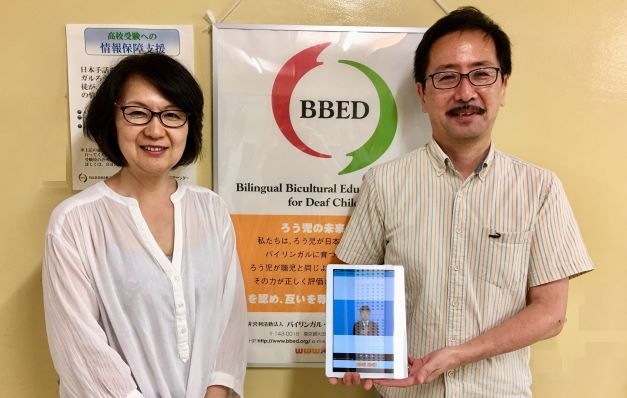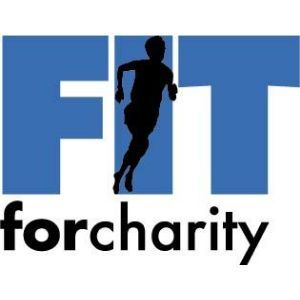NPO Bilingual Bicultural Education Center for Deaf Children
The Bilingual Bicultural Education Center for Deaf Children, a non-profit organisation selected as a recipient in 2018, supports deaf children (deaf or hard-to-hear children) to receive education in 2 languages: Japanese Sign Language and written Japanese (reading and writing). Furthermore, it is an organisation that promotes the creation of a society in which deaf children can demonstrate their abilities to the fullest in the same way as children who can hear. We spoke with Masami Tamada, the president of the organisation.

Mr. and Mrs. Tamada demonstrating a prototype
FIT: How did you start BBED?
Tamada: I founded the Bilingual Bicultural Education Center for Deaf Children (“BBED”) 17 years ago, in 2003. I found out that my second son was deaf when he was about 1 year and 9 months old and went to a Deaf Free School, "Tatsunoko Gakuen," that was run voluntarily by young deaf people.
At that time, schools for the deaf in Japan did not provide education in sign language, and it was considered good practice to provide oral education for deaf people to be able to hear and speak as well as those who can hear. People who cannot hear cannot speak because they cannot hear or recognise their own voice. I wanted to raise my second son in sign language, so I was at a loss on how I could communicate with him.
First, I consulted the staff of the "Tatsunoko Gakuen" where my second son was attending and established the NPO Bilingual Bicultural Education Center for Deaf Children to stabilise the free school activities. At the same time, we tried to encourage the government and the Tokyo Metropolitan Government to allow people to receive education in sign language, even in public schools, but this was not possible. So in 2008, we established a new private school for the deaf, "Meisei Gakuen," to provide education to deaf children in Japanese Sign Language as a special educational district of the Tokyo Metropolitan Government.
FIT: Please tell us about the main activities of the organisation.
Tamada: We support deaf children (deaf or hard-of-hearing children) to receive education in two languages: Japanese Sign Language and written Japanese (reading and writing).
There is a statistic that one or two out of 1,000 newborns have difficulty hearing. When a child with hearing impairment was born into our family even though his parents could hear, parents are naturally confused and anxious. For this reason, we hold face-to-face meetings on parenting and provide educational counseling to families with children who have difficulty hearing and hold Japanese Sign Language classes for families as well.
We also provide information, organise networking events, studies and lectures, conduct joint research with experts and companies, create books and videos that disseminate Japanese Sign Language, provide "remote interpretation system" for deaf high school students studying at ordinary high schools, and collect data on bilingual deaf education.
FIT: Can you tell me more about Japanese Sign Language?
Tamada: The Japanese Sign Language used by deaf people is a different language from spoken Japanese. It is a natural language, which deaf people can understand 100% and is their mother tongue.
It is not well known, but the Japanese Sign Language has a unique grammatical system and the word order is different from spoken Japanese. The shape, location, and movement of the hands are not only meaningful, but also the direction of the shoulders, slight facial expressions, the angles and movements of the eyebrows and mouth are grammatical.
On the other hand, the “Japanese Language Sign Language”, which we see on TV for instance, is a set of spoken Japanese words that is interpreted into sign language. The Japanese Language Sign Language does not use those unique grammars mentioned before.
The original form of the Japanese Language Sign Language was made by people who can hear, so it feels unnatural to deaf children and difficult to understand. There are nearly 100 schools for deaf children in Japan, but only few offer classes in the Japanese Sign Language, the first language of the deaf, and many of them use the Japanese Language Sign Language.
FIT: Why is that?
Tamada: For about 80 years from 1933, deaf people were taught to use only oral language and sign language was banned. There was a common misconception that if you used sign language, you won't be able to learn Japanese. Hearing with a hearing aid and imitating the shape of the mouth was the basis of their education. The goal for deaf children was to be able to hear and speak as children who can hear and because the deaf children spent so much time speaking in Japanese, they were unable to acquire sufficient academic skills.
FIT: I didn't know that there are two types of sign language, Japanese Sign Language and Japanese Language Sign Language. Does that create any problems?
Tamada: It is said that 90% of children who cannot hear are born to parents who can hear. As a parent, you want your child to be able to hear something, even if it not perfect. We felt that way too at first.
Doctors also recommend cochlear implant, but it doesn't allow you to hear, it just changes your hearing. For example, a severe hearing impairment that becomes a mild hearing impairment does not solve the problem.
Suppose you have mild hearing impairment and can say the word "apple". But what is an apple? If you don't understand that the fruit is red but different from watermelons, or similar in shape but different from pears, and you don't understand the term "apple," you don't truly understand the word. So even if you know the language, you won't be able to understand unless you have developed the concept.
There are many deaf children who speak Japanese fluently, who speak as if they were parrots and don't understand the meaning of what they are saying. In order to be able to talk deeply and understand other people's feelings, we need to develop the concepts through many meaningful conversations and experiences.
FIT: Please tell us how you are utilizing the FIT donation money?
Tamada: We will use the funds to develop an AI dictionary that you can look up words from sign language. The AI recognises and reads the sign language and displays the Japanese word and example sentences on the screen. The purpose of this dictionary is for deaf children to use when they are writing compositions and sentences. We are currently developing a prototype by gathering samples in formal and basic Japanese Sign Language and analysing them.
We collect sample movements for each word from native Japanese Sign Language speakers. First, we select a word, which has movements that are easy to recognize. There are also words that are combined with CL (a method of expression peculiar to sign language called analogy or classifier), so collecting the samples is a monumental task.
During the first year of this project, we planned to be able to recognize about 10 words recognised. Of course, 10 words is not enough for practical use, and we hope to eventually achieve about 100 words. We still have a long way to go, but I am very grateful to FIT for helping us take our first step.
FIT: What are your goals and plans for future activities?
Tamada: Deaf children speak in sign language or “the children of the eyes”. We are working to establish equality of those who can hear and of those who speaks a different language (= someone who speaks in sign language).
I want children who cannot hear to live on an equal footing with those who can hear and have their own identity when they start working in society. We want to create a society in which the use of sign language is accepted as an individuality and the children can demonstrate their abilities and be appreciated. And to that end, we (BBED) believe that it is important to support deaf children and their families by taking on the responsibilities of public relations, obtaining subsidies, and working with the government on their behalf.
Bilingual Bicultural Deaf Education Center
http://www.bbed.org/

